Chakra Healing in Children
Chakras are energy centers inside us that guide us on our path to higher consciousness and aliveness. Our chakra system, as the architecture of the soul, provides a crucial blueprint for our own growth and completeness. Looking at child development through the chakra system’s perspective may give parents with some very significant knowledge, which most parents are not exposed to. You may be shocked to learn how closely the chakra system is linked to attachment parenting vs gentle or calm parenting vs neglected parenting. Interestingly, knowing the chakras may be beneficial if your kid has sensory processing disorders or behavioral disorders or a variety of other health (emotional and physical) concerns. You should be able to quickly tap into the impacted chakra based on your child’s age and ailment to bring about greater balance, awareness, and healing.
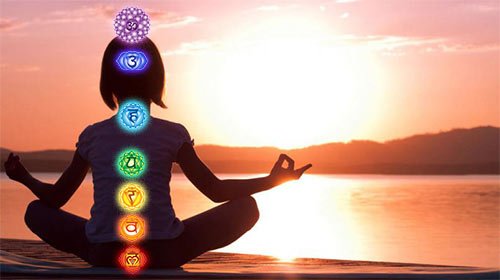
Every seven years from the time a person is born, his awareness automatically flows through one of the chakras to another, and then to the next. Right after a baby is born he is in the Muladhara chakra from the age of 1 to 7 and this energy center sets the foundation for a settled energetic development at all other chakras. From the age of 7 to 14, he is in the Swadhisthana chakra, asking, “Why? “Why this?” and “Why that?” and the child’s curiosity for blending with the world increases. And then, a time comes when he wants to run away from home, between the ages of 14 and 21, because he doesn’t want to be told what to do or when or how to do by anyone, he is in the Manipura chakra. Our research at Chakra Yog is supported by significant astrological cycles, particularly the 7-year Saturn cycle, which is associated with our growth and the process by which we evolve into our most authentic selves while it nudges us to do so. This cycle begins the moment we are born and keeps evolving through life.
Balancing the chakras is one of the most essential things you can do to assist your child’s body, mind, and spirit, according to traditional spiritual traditions and modern quantum biologists. When the biofield of your chakras is tuned up, the immune system is strengthened, and the natural intelligence of your child’s DNA can express for higher levels of optimal health during the growing years.
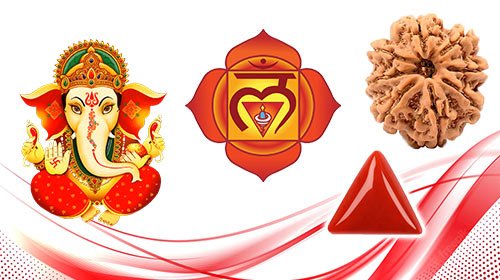
A child’s foundation is the root (Muladhara) chakra, which is located at the base of the spine. It is associated with survival instincts as well as a child’s sense of grounding and connection to their body and the physical plane because it represents the element earth. This chakra is the first energetic field to be activated following birth. It has cellular memory that goes back at least three generations of genetic imprinting, which starts even before birth in the uterus and reaches its full energetic potential during the first years of life. This chakra houses the powers of time and memory, as well as karmic patterns from previous lives. We use the forces of this chakra when we return to our memory patterns. Furthermore, because this chakra is governed by the planet Ketu, we can gain a better understanding of the potentials and drawbacks we bring to this life by analyzing how Ketu is placed in the birth chart. In other words, this is our supporting chakra, and we build our lives from this energy center.
Children love Ganesha more than any other god and for a good reason, He is the presiding deity of the root (Muladhara) chakra and his healing energies makes kids feel safe, secure and happy. Lord Ganesha is well-known for his ability to remove obstacles which makes him to be revered by kids. The 8 mukhi Rudraksha is the bead associated with both Lord Ganesha and Muladhara chakra. Many of the issues faced during childhood due to a weakened Muladhara are quickly stabilized by wearing it, resulting in a perfect supportive foundation for the child’s skills development and personal growth. Also gemstone coral empowers this chakra and gives the necessary strength to the child to stand on his own feet.

In children, a weakened root chakra appears emotionally as an inability to feel grounded and supported. There is an inability to feel comfortable, nestled, safe and secure in one’s connection to one’s home. It is common to detect a separation from family routines and standards. On a physical level, this manifests as trouble maintaining a healthy weight, which may result in being either overweight or underweight. The child feels lazy and procrastinates on things and tends to oversleep. Bone and tooth abnormalities are common symptoms. Complications with the base of the spine, including the buttocks, legs, knees, and feet are particularly common.

A Muladhara chakra blockage develops in a child who is estranged from his or her parents or feels deprived of basic necessities (emotional and physical support, sustenance, emotional and physical steadiness). Violence in the family wreaks havoc on the child’s stability, leading to psychological traumas associated with this early instability that can last for the rest of his or her life. Anything unstable in the child’s environment, whether it’s frequent changes of residence or school, a lack of physical presence of primary parental figures, or whatever the toddler perceives as unsteady, will disrupt the Muladhara chakra in some way.

The most vital thing you can do at this phase is to help your child fully integrate into his or her body. The value of regular touch, holding, carrying, nurturing, and attention to physical needs cannot be overstated. Your touch validates your physicality. Your help teaches your child how to fend for himself. Playing with your child promotes motor coordination development. Playing with his feet and hands, offering toys he can grasp, and bath time all help with motor development. Setting up a safe and comfortable environment with age-appropriate toys helps the child connect to the outside world in a positive way.
The child’s only source of protection is attachment to the primary caregiver. Throughout the child’s first years, it is vital for the mother (or father if he is the primary caretaker) to be there as often as possible. This involves scooping the kid up when cries, holding and stroking he or she on a frequent basis, conversing with him, protecting him from loud noises, hunger, cold, or discomfort, and feeding him when he is hungry rather than on a schedule. Some parents have difficulty enabling this link to grow since the child’s intrinsic neediness seems unduly demanding. Allowing this link to form benefits the child’s future independence. The continuity of presence throughout infancy assists in balancing the trust vs. mistrust dilemma in a way that supports optimism and confidence. Knowing that the father or mother is always there allows the child to relax and focus on the essential development rather than being anxious and hypervigilant.
If the mother must work during the first year and is unable to be there for her child, she disadvantages her child. Unfortunately, owing to financial limits, this is often the only option. The most important thing parents can do is provide the best possible child care while simultaneously acting as advocates to ensure the child gets the care he or she needs. When searching for daily care, parents should examine if the child is handled on a regular and suitable basis, fed on demand, and cared for by competent workers in an age-appropriate environment. It is also important for her to spend time with her child during daily care until she becomes used to it. Family daily care and in-home babysitting are more likely to offer continuity and consistency when they are available. Furthermore, the mother must know that the child may need extra care, interaction, and mother-child connection during the nights at home. A safe environment creates a feeling of security. It is vital to have calm in the home, as well as protection from loud noises, sharp objects, falls, cold, and adult or sibling hostility. Keep in mind that the infant’s surroundings is his or her own self. What they are engrossed in has the most impact on who they are. When the child is in an unfamiliar setting, such as a shop, a park, a doctor’s office, or a friend’s house, the parent provides a safe haven for the child. Recognize that your child will be more restless and will seek your reassurance more often.
Breast feeding has been proved to be both emotionally and physiologically beneficial, since breast milk comprises important antibodies, and breast feeding enhances mother-child bonding via physical touch. However, studies have indicated that the mother’s emotional state while feeding is more important than whether the infant is breastfed or bottle fed. A bottle presented tenderly is superior than a breast offered resentfully. Healthy nutrition on the part of the mother, avoidance of hazardous substances in the milk, and healthy nutrition when the newborn first begins ingesting food are all critical components of growing a healthy body. If you navigate this period well, you will equip your child with a stable platform from which to handle the myriad challenges that life will hurl at them. The child will be conscious of her or his own body and aliveness, as well as a sense of hope and optimism that the world can and will meet his or her needs.
The sacral chakra, located in the belly, lower back, and sexual organs, is linked to the element water as well as emotions and playfulness. It connects children to others through emotions, desires, sensations, and movement. In its ideal state, this chakra provides fluidity and elegance, depth of emotion, and the ability to tolerate change. As the child grows up and is established in Muladhara, a down-to-earth energy center, Swadhisthana begins to naturally open, allowing the child to develop a unique emotional identity that allows him or her to navigate the social world around him or her while oriented to self-gratification, joy, and emotional expression. The Moon is the planet that rules this chakra and is associated with childhood memories and reactions. The placement of our natal Moon in the birth chart reflects how fluid or blocked this chakra is and which emotional areas we need to work on to bring this energy center back into balance. This chakra is where we develop our sense of self in the external world, and where we begin to develop our social identity in relationships.

Children begin to blend into the world with innocence and joy, meeting others and gradually forming their own identity among others. They go through this experience, like Lord Krishna, the presiding deity of Swadhisthana chakra, feeling cool and detached but enjoying it in depth, naturally reverberating with Krishna energy. Swadhisthana chakra is healed by wearing 2 mukhi Rudraksha and empowered by wearing pearl. Most of the problems encountered by a child with an enfeebled Swadhisthana chakra can be quickly managed and eventually resolved by wearing them resulting in a perfect supportive foundation for the child’s emotional and social development.
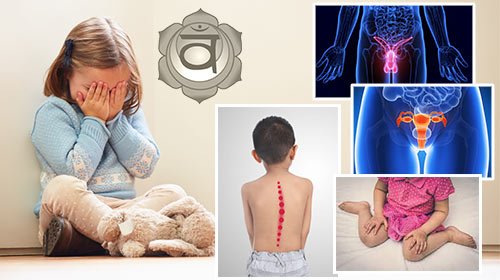
Swadhisthana chakra is linked to a wide range of emotional and mental issues in children. Because of the interlacing between this chakra and Muladhara, we must dig deeper into the root chakra in some cases to find the root cause. Children who experience either detachment or obsessive attachment to family and friends have an imbalanced Swadhisthana chakra. If they are ruled by emotions most of the time, showcasing hysteria and tantrums, it means they are overwhelmed by their own emotions as a result of an overactive Swadhisthana. In general, emotionally sensitive children who are above or below the average indicate an imbalanced Swadhisthana. Addictions to food and video games are also warning signs. On a physical level, issues related to the reproductive sexual organs, disorders of the spleen and urinary system, lower back pain and inflexibility of joints have all been observed when this energy center is out of balance.

When too many norms and rules are imposed on children and how they should express themselves in the world in order to be “good kids,” it blocks their natural flow of interaction with the external world beyond their family, as with friends and schoolmates, causing an imbalance on this chakra. When early life issues rooted in Muladhara are not resolved and freed during later years while Swadhisthana is active, this chakra will run more slowly than usual. Problems at school with buddies frequently cause an imbalance at Swadhisthana chakra too.

Your kid will now be in the hatching stage, separating from you as a parent as his body develops and permits him to move more and more. Because this is frightening to him, he will move back and forth, going away and then returning to check whether everything is well. In some respects, he’ll seem even more connected, which is normal. It is critical to support both of these processes – to promote separation by providing safe places to explore and by being warm and loving when reassurance is required. At this stage in your child’s development,
it is critical to reassure him that he or she has complete freedom to go wherever he or she wants to go, while also assuring him that his base home where he was born and taken care it will remain always there in the same place waiting for him.
Your child is learning about the world via his senses. This is his primary method of experiencing at the moment. Colors and noises, intriguing objects, touch and enjoyment via play, and a secure atmosphere to explore are all vital. The sensate experience is heavily reliant on your voice and attention, as this builds up his self-esteem. Create a space for your child to explore various forms of sensitivity tuning, such as music, by having a piano at home at example, paintings, readings, different focused game activities, sports, and so on, in order to naturally lean your child towards his or her unique talent and gifts.
Your kid is eager to get moving right now. This is not the time for a playpen, and if you must use one, do so for brief periods of time. Instead, take him to locations where he can safely crawl and walk, where he may run in the park, roll about in the yard, and learn to utilize his body in its newfound delight of mobility. Take him to camping in the woods or to spend whole weekends on the beaches or the coastline where he or she may encounter plenty of open spaces to trek over and explore these new territories in total freedom. By encouraging your child to talk with the animals and strangers he or she might find across his path, he learns to flow with the environment around fluidly making him return home happy, more confident and knowledgeable of his surroundings. This practice makes him or her to let go from past fears and memories by providing refreshing experiences.
Your child is developing emotional language. It is critical to reflect his emotions if you wish to teach emotional literacy. Respond to his shouts and displays of fury, fear, need, or perplexity. Don’t dismiss or penalize him for his feelings; he can’t change how he feels. “How sad you seem right now!” reflect words to show him you understand. “Are you afraid?” Would you want Mommy to hold your hand?” Despite his inability to talk appropriately about his feelings, he is learning to grasp how to do it by listening others around. He will realize that his emotions have names and that he may convey his needs and desires to others even if he does not speak. Be aware of your own emotional demands and moods, as well as the household’s emotional “field.” Children absorb our fury, fear, worry, and delight. Take care of your own needs as much as possible to avoid projecting your unresolved feelings onto the innocent child. Create a pleasant atmosphere.
Manipura, situated in the solar plexus, is known as the power chakra. It governs the personal strength, will, and autonomy of children, as well as their metabolism. When functioning properly, the solar plexus chakra provides children with vitality, effectiveness, spontaneity, and non-dominant power. It is ruled by the Sun, which is at the core of our life purpose or dharma, our inner call to be fulfilled. Once the solar plexus chakra starts to awaken and open to the child’s awareness, he or she starts to feel compelled to follow this inner path. This coincides with the age this chakra is operative at its peak, between 14 and 21 years old, a critical time when youngsters choose their career after primary schooling is completed. This is a period oriented to self-definition of our ego in society and it is remembered as the most vigorous phase of our lives later as adults. It is from this energy center that we start to establish ourselves firmly in the world for what we can accomplish.

Children begin their transition to adolescence with a desire to experiment on their own in autonomy and independence from their parents. When they realize what they truly want, they are drawn to forge their own path, regardless of what their parents expect of them. This rising and shining self-determination resonates with Lord Surya’s vital energy. He is the solar deity and rules the Solar Plexus chakra, which is active during adolescence. It is during this time that all hormonal levels are at their peak, and there is a strong urge to be ourselves irrespective of what society expects of us. 12 mukhi Rudraksha illuminates the path of the teenager towards adulthood by giving the wearer the quality of the sun to shine, which is critical during this typically confusing transitional period from child to adult.
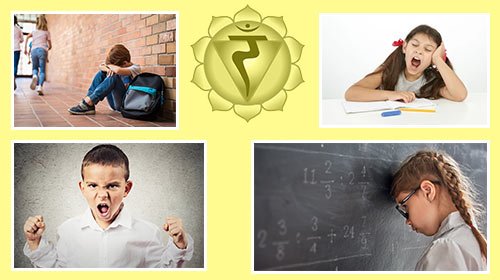
In children and teenagers, an imbalanced Manipura showcases as low energy and motivational levels, dependency on others, lack of enough self-respect and a fearful attitude to society. They can be spotted at school as victims of bullying. On the other hand, when this chakra is overactive they can turn aggressive, domineering, egotistical, stubborn and emotionally intimidating and manipulating of others. On a physical level, this imbalance translates into digestive disorders, indigestion and ulcers, gall bladder and liver ailments and chronic fatigue.

When co-dependency issues with family and friends are not resolved, and the child continues to feel dependent on the opinions and views of his parents and other influential people in his life, or even responsible for them in such a way that their own potential cannot stand alone, the solar plexus chakra cannot shine in its full splendor, and the child’s overall vital energy is dwindled. Too much parental and teacher pressure on the adolescent results in a range of behaviors ranging from resignation to over-functioning against the established norms.

Since the ego identity is emerging at this period, celebrate your child’s successes and make him feel acknowledged. Encourage his independence without dismissing him. Giving your kid activities that he can do effectively can help him build confidence. Small activities around the home, such as placing toys in a box or cleaning up stuffed animals, may assist to establish a fundamental feeling of confidence. If he persists on doing something above his skills, such as choosing his own activities, assist him in completing these. By all means, don’t be too judgmental or annoyed by his uncomfortable efforts to perform basic tasks. Have some patience. He is in a very dynamic and pushing phase now and it will be worthwhile in the long term. As parents, we want our children to be proud of who they are. The fact is that the adolescent years are full of transitions. As teenagers seek their position in the world, many face experiences that call into question long-held assumptions about themselves. You may boost their self-respect by demonstrating that you care about their ideas and emotions, as well as their skills and abilities. As kids begin to connect with others outside the house as part of socialization, their self-esteem will continue to increase. Allowing teenagers to express their ideas and emotions in a safe setting is the most effective strategy to boost them. Instead of approaching your kid as a subordinate, encourage them to speak favorably about themselves by asking open-ended questions and building a feeling of respect and support between you. Self-awareness is also an important component of self-respect. Being conscious of your own strengths and shortcomings, as well as your values, beliefs, and principles, may assist you in setting realistic objectives and avoiding negativity caused by feelings of inadequacy.
Celebrate your child’s independence when he or she starts to separate. Try, as difficult as it may be, to encourage his willfulness by providing options wherever available. Rather of asking, “Do you want Cheerios?” “No!” “Would you want corn flakes?” “No!” “Would you want oatmeal?” “No!” and then, annoyed, “Do you want Cheerios, corn flakes, or oatmeal?” Alternatively, you may select two appropriate choices and let him choose. Willpower is more than merely saying “no” to things the child dislike. It’s also about carrying out commitments even when they’re difficult. Discipline is necessary for willpower to succeed. Having your child do the same duties every day might help him or her develop a feeling of responsibility. Teaching a hyperactive teenager about discipline and willpower might be difficult at times, but it is doable. Leading by example is an effective way to instill willpower in your child. Don’t give in to temptation if you want to purchase something but have other priorities at the time. Through doing so, you will educate your youngster willpower by example. Similarly, if you’re on a diet, attempt to set a positive example. Remember that you must be a role model for your children in order to teach them how things should be done and the advantages of consistency. Request that they do particular activities on a regular basis. You may, for example, ask them to make the bed after waking up or to assist set the table before dining. To keep kids from becoming bored, you might ask them to assist you with a variety of duties. Finally, allow your kid to express his or her independence in safe and acceptable ways.
As parent, you definitely cannot give up full control in order to promote your child’s autonomy and will. Appropriate and strict limitations must be of course established. Simple cause and effect statements, such as “Doggie bites!” are sufficient for your growing child to grasp. “Don’t touch!” is understandable for him but he won’t accept being told what he must to do at this stage. Severe punishment instills aggression and promotes humiliation, so try to avoid it as much as you can even if it is tough. Withdrawal of affection isn’t a good attitude either, furthermore it can block the opening of the immediate upper chakras as Anahata creating about more harm than good, as well as increases the child’s insecurity and desire for acceptance. Instead, attempt to transfer your child’s focus to a more suitable activity and remove him from potentially hazardous circumstances. At this age, limits and disciplined habits are very productive but they should be suitable to your kid’s nature and rhythms. They should be short timed and agreed with him in order to work out. Keep in mind that the ultimate goal of any discipline plan is to put your child on the path to achieving his or her highest possible performance in the route that he or she has chosen. Flexibility and knowledge of your child’s temperament, as well as of his own way of doing things and making progress, are essential in helping your child succeed.

Chakras in children, like any other physical gland of the body, are energetic systems that develop during the growing years. Early impressions and imprints on them at this stage can influence how they function for the rest of their lives. Similarly, children and their chakras are extremely sensitive to the healing vibrations of Rudraksha beads, which manifest their effects much more quickly and profoundly than adults. Rudraksha beads are popular among children as pendants or bracelets because of their properties in the biofield of the child. They pair quickly and become inseparable, serving as amulets for them. As observed by their parents’ testimonials, RRST combinations designed for children have been shown to be extremely effective and miraculous.
Children’s upper chakras are not found to be usually imbalanced unless it is due to past ancestral, inherited, or karmic patterns. Children do not judge (Ajna), mistrust (Anahata), compare (Vishuddha), or are dissatisfied (Crown). Rudraksha can heal throat problems, headaches, migraines, epilepsy, and other brain-related disorders associated to the upper chakras, but these problems are the result of karmic issues and hence they need professional counselling.
When dealing with chakras in children, the primary focus for their well-being and healthy development is on the first three foundational chakras, whose balancing state is essential for the optimal functioning of the upper chakras both during their growing years and later in life.
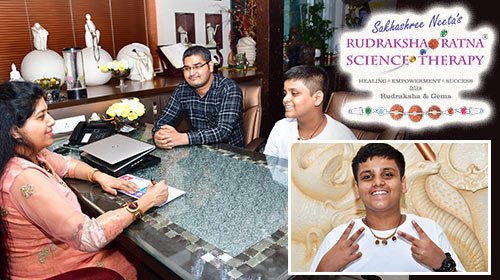
As we have seen, your child’s proper and progressive development is primarily reflected in the first three chakras, namely Muladhara, Swadhisthana, and Manipura. According to recent research, these are the most commonly found imbalanced chakras in adulthood, and therapists must delve back into the person’s childhood to determine the causes of these blockages. Supporting
these vital energy centers is a tried-and-true way to ensure your child’s mental, emotional, and physical well-being. Rudraksha Ratna Science Therapy is now
the most advanced and proven method available for achieving this goal in a practical, professional and consistent effective manner.
You can now book an instant Video call consultation with us. Discuss your problems related to your child’s emotional and overall health, personal schooling blocks and get his or her Chakras analyzed. We will then email you your Chakra report along with Rudraksha RRST remedies for your child’s healing, well-being and successful development.

Chakra Yog’s Knowledge base has evolved from Advaita Vedanta teachings and from Bhagwat Gita’s four paths to Union.
Connect With Us

Chakra Yog,
C-309, Neelkanth Business Park, Nathani Road, Behind Vidyavihar Railway Station, Vidyavihar (W),
Mumbai – 400086, Maharashtra, India.

Open: Monday – Friday: 8.00am – 7.00pm
Close: Saturday – Sunday – Holiday



